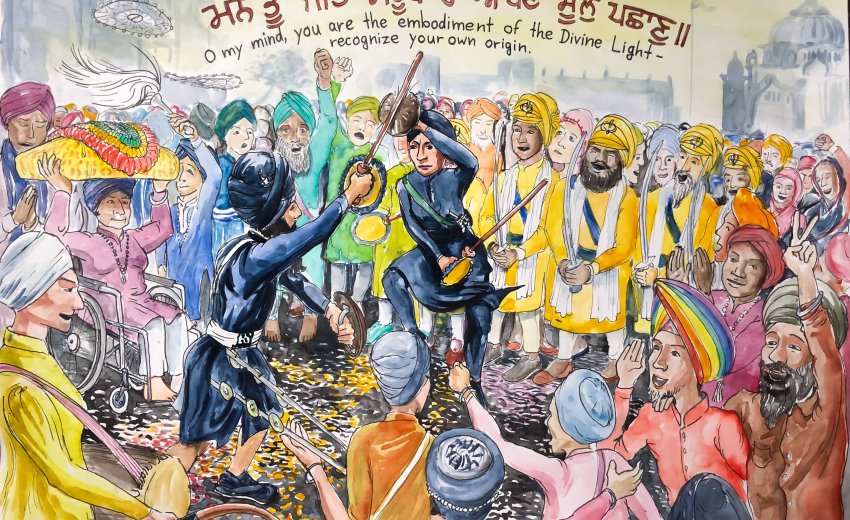As the vibrant colors of the rainbow adorn the streets and celebrations ignite worldwide during the month of June, Pride month stands as a powerful symbol of inclusivity and acceptance for the LGBT+ community. Amidst this jubilant atmosphere, it is essential to recognize that many LGBT+ people from religious communities do not feel they have much to celebrate as homophobia, transphobia and biphobia increase to unbearable levels, whilst the decent majority sit by silently and watch this abuse taking place. In this article, I delve into the experiences and resilience of LGBT+ Sikhs, shedding light on the journey of self-acceptance and the valuable contributions to the Sikh community.
The intersection of being both Sikh and LGBT+ (written from a cis man’s perspective), presents a distinct set of challenges and triumphs. Sikhi (aka Sikhism) is a religion founded on principles of equality and social justice. The Sikh Gurus were clear and the Guru Granth Sahib (Sikh Holy Scriptures but also our eternal living Guru), teaches that all individuals are equal in the eyes of the Divine, but more importantly, we are all part of the One Divinity, the Almighty. However, cultural norms and some conservative interpretations pose obstacles to acceptance for LGBT+ people within the Sikh community. Despite these challenges, there are many courageous individuals within the Sikh community who have emerged, both embracing their multiple identities and some vocal allies who are also advocating for greater inclusivity, but we need the silent majority to step up and become advocates for equality and inclusion in line with the Guru’s teachings.
For LGBT+ Sikhs, the process of self-acceptance often involves reconciling one’s own sexual orientation and gender identity, whilst being part of a faith community which doesn’t engage in these conversations. At times, this can push young LGBT+ people out of their faith community, as well as potentially facing rejection from their families and friends which can sometimes lead to ostracization from the wider community. All this happens while navigating through complex emotions, fear of judgement, and societal pressures as a backdrop for young LGBT+ Sikhs. Some individuals find solace and strength in the teaching of Sikhi itself, which emphasises love, compassion, and the pursuit of truth. Some are also fortunate to be part of a supportive and inclusive community. With unwavering determination, LGBT+ Sikhs tend to embark on a path of self-discovery and these days can find support remotely from Sikh religious organisations, as well as groups such as Sarbat LGBT+ Sikhs who were founded to support LGBT+ Sikhs.
The LGBT+ Sikh community have taken significant strides in fostering a sense of belonging and acceptance within the broader Sikh community, however although these allies show acceptance and love, they do not openly advocate for the LGBT+ community. More organisations and support groups are following in Sarbat’s path, such as Sher Vancouver, The Queer Sikh Network, and others to pave a way for future generations to embrace their authentic selves without fear or shame, by providing safe spaces, resources, and platforms for dialogue.
The journey of LGBT+ Sikhs in challenging societal prejudice and fostering acceptance is a testament to their resilience and courage, even more so, when LGBT+ Sikhs face just as much prejudice and discrimination for being a visible faith minority within the broader mainstream LGBT+ community. By challenging stereotypes and breaking barriers, they are contributing to the growth and evolution of the Sikh community as a whole. Their advocacy extends beyond the boundaries of the LGBT+ community, promoting empathy, compassion, and equality for all individuals, irrespective of their sexual orientation, gender identity, race, disability, age, caste, class, etc.
Pride month is a difficult time for LGBT+ Sikhs because it coincides with the commemoration of the martyrdom of Sri Guru Arjan Dev Ji (Fifth Guru of the Sikhs) and the anniversary of Operation Bluestar and the genocide of the Sikhs. The juxtaposition of remembering Guru Ji’s martyrdom for the freedom to practice one’s faith with some Sikhs attacking LGBT+ Sikhs and causing harm is a stark paradox. However, there is also space to acknowledge and celebrate these diverse identities within the Sikh community. By embracing LGBT+ Sikhs and their contributions, we can honour the rich tapestry of human experience and reaffirm the values of inclusivity and love that Sikhi espouses. Pride month also serves as a reminder that the Sikh faith and LGBT+ community are not mutually exclusive; they intersect and thrive together, and allies can follow the teachings of Guru Ji and stand up for marginalised groups.
As we commemorate Pride month, which started as the fight back by LGBT+ people in New York against discrimination, violence and harm, let us embrace the stories, triumphs and challenges of LGBT+ Sikhs. By recognising their resilience, we affirm our commitment to inclusion and understanding within the Sikh community and beyond. Let us stand united in the pursuit of equality, acceptance, and love, forging a path where every Sikh, regardless of their sexual orientation or gender identity, can proudly and authentically be themselves.
The journey of LGBT+ Sikhs is a testament to the power of authenticity, resilience, and advocacy. By navigating these complex identities (being a minority within a minority group), they exemplify the spirit of Pride month as well as following the example set by Sri Guru Arjan Dev Ji of maintaining a positive attitude in difficult situations, while also promoting inclusion, acceptance and love. As we celebrate the colourful mosaic of humanity during Pride month, let us all stand in solidarity with LGBT+ Sikhs and strive for a world where all individuals can embrace their true selves without fear or prejudice.
Pritpal Singh
Sikh LGBT+ Inclusion

